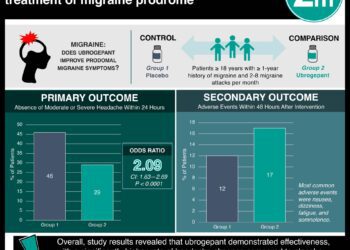Childhood migraine associated with infantile colic
Image: PD
1. Children diagnosed with migraines likely suffered from infantile colic.
2. There was no association between children with tension-type headaches and a history of infantile colic.
Evidence Rating Level: 3 (Fair)
Study Rundown: This study explores an interesting association long thought to exist between infantile colic and migraines. Children and adolescents presenting to the Emergency Department for migraine had a significantly higher prevalence of history of infantile colic than controls. This raises questions about the assumed pathogenesis of infantile colic, commonly assumed to be abdominal pain. Clearly infants with colic are distressed, and many gastrointestinal interventions are often unsuccessfully attempted. Although abdominal migraine is a known clinical entity, colic may represent a more general form of autonomic instability, manifesting with a fussy infant. Similarly, migraines have also been linked to autonomic dysfunction. Interestingly, sleep allows for self-regulation of the autonomic nervous system, and poor sleep quality is known to be a trigger for migraines. Interventions targeting sleep consolidation and improvement in infants’ circadian rhythms warrant future study to possibly play a role in the therapeutic management of colic and migraines.
This study was well designed, further bolstered by analyzing a cohort with tension-type headaches to compare against the migraine cohort. Nonetheless, there are several limitations. Besides the inherent biases in case-control studies and the potential for recall bias, this study only considered children presenting to the ED. For example, these cases may reflect a population with worse symptomatology or different socioeconomic characteristics than those children who may present to their outpatient pediatrician. Further longitudinal studies are needed to validate these findings while increasing our understanding of a mechanistic relationship between migraines and infantile colic.
Click to read the study, published today in JAMA
Click to read an accompanying editorial in JAMA
Relevant Reading: Migraine in the pediatric population—evolving concepts
In-Depth [case-control study]: A total of 328 children aged 6 to 18 presenting to the Emergency Department (ED) in three European tertiary care centers were diagnosed with primary headache (migraine or tension-type) and enrolled in the study. There were 471 controls. Parents completed surveys and children’s national health booklets were reviewed to determine history of infantile colic using Wessel criteria. In the group of children with migraine, 72.6% reported infantile colic, while the control group reported a 26.5% prevalence (p < 0.001). In the group with tension-type headache, the prevalence of infantile colic was 35.0%, which was not a significant difference against the control group.
By Mike Hoaglin and Rif Rahman
© 2013 2minutemedicine.com. All rights reserved. No works may be reproduced without written consent from 2minutemedicine.com. Disclaimer: We present factual information directly from peer reviewed medical journals. No post should be construed as medical advice and is not intended as such by the authors or by 2minutemedicine.com. PLEASE SEE A HEALTHCARE PROVIDER IN YOUR AREA IF YOU SEEK MEDICAL ADVICE OF ANY SORT. Content is produced in accordance with fair use copyrights solely and strictly for the purpose of teaching, news and criticism. No benefit, monetary or otherwise, is realized by any participants or the owner of this domain.





